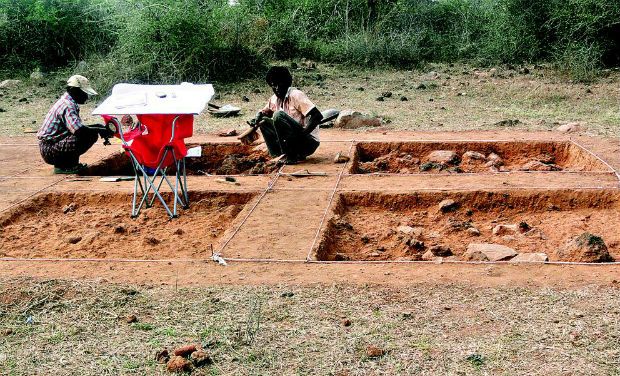Chennai:
North Tamil Nadu has been industrially active — at least 2,000 years ago! This surprising piece of information could provide ample lead to probably rewriting the history of mankind and his abilities to utilise natural resources to make iron-based tools and utensils.
In addition to an ironsmelting unit in Kariamankalani village, evidences of the earliest human settlements — presumable that of well-organised tribes who knew the uses of iron was discovered for the first time in Kariamankalani village about 30 km from here. Both these discoveries came to light during a recent excavation by S. Rama Krishna Pisipaty, professor and geoarchaeologist, SCSVMV University, Enathur They seemed to have mastered the art of making blocks with iron ore and charcoal husk. “The settlement shows signs of early living place of humans and contains evidences of temporary huts,” says the professor who unearthed stone boulders at the site near Vadamangalam, a nondescript village near Sriperambudur.
The big boulders were used to form a circular structure. About 50 such circular structures besides 20-25 iron smelting units using bloomery method has been unearthed for the first time in northern Tamil Nadu. Also some 15 x 10 cm rectangular blocks were found. “It may not be workers’ dwelling places,” Pisupaty said in reply to a query.
Though people were nomadic at that time, they however lived in groups close to the places where natural resources abounded. “This explains the presence of habitations near the smelting units. Hardly 3 km away, last year I had found the tortoise-shaped burial grounds dating back to the same period,” he adds.
Besides a mountain, a lake also exists close to this site. Preliminary estimates reveals that the people during the Iron Age had extracted iron, purified the metal and made blocks, which were exported to other places.
Pipes (for blowing wind and cooling the molten iron) of varying sizes are also found. At Palnerllur in 2010 the same team discovered iron smelting and smithy. The present site is much earlier than the Palnerllur site. Human activities at the new site dated back from Stone Age.
Pebble and other microlithic tools were also found, says professor Pisipaty.
source: http://www.deccanchronicle.com / Deccan Chronicle / Home> News> Current Affairs / by J. V. Siva Prasanna Kumar – DC / March 31st, 2013
